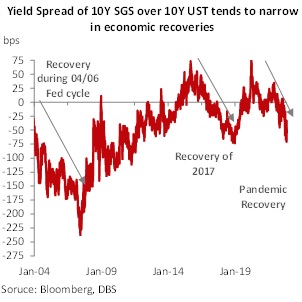
The 2023 SGS issuance calendar got released yesterday (see here). There are several observations from our end.
- The number of issuances planned for 2023 is set at 10, unchanged from 2022, with the last issue planned for September
- Of the 10 issues, only a 5Y issue (planned for July) is new, the rest are reopens (which tend to be of smaller size)
- The accompanying statement indicated that “outstanding SGS bonds is expected to grow at a healthy albeit slower pace than in 2022” (see here). Total outstanding SGS is up by about 8% this year and an average rate of about 9% over the past five years.
- The MAS plans to reopen the 50Y Green SGS (Infra) bond some time in 2H23
- Duration looks to be backloaded in 2023 with a 30Y SGS (Infra) auction scheduled for September and the reopen of the 50Y Green SGS (Infra) bond in 2H23
We think that the conditions for SGS curve steepening (2s and 5s outperforming 10s and 30s) into 2023 are in place. Note that this is a medium-term view that assumes that the Fed will pause in 1Q and rate cut pricing will factor into the 2Y-5Y tenors of both UST and SGS. This would also broadly gel with the SGS issuance calendar backloading duration into 2H23. It also helps that term premium in SGS is finally correcting (the SGS curve is no longer too steep compared to the UST curve). The last factor to consider on the curve would be on overall SGD liquidity. The unleashing of retail monies appears to have capped T bill rates and this has consequent spillover unto MAS bills. Considering also net withdrawal from bill issuances, USDSGD and SORA fixings, SGD liquidity might no longer be that tight.
While SGS might look expensive relative to UST by recent standards, we see balanced relative value risks heading into 2023. Using the 10Y tenor as a proxy, we can clearly see SGS outperformance during times of recovery and underperformance during times of crisis. The pandemic recovery was unusual as volatility spiked on the back of high inflation, aggressive Fed hikes and China’s COVID zero policy. With the USD strong, SGS outperformance took a more volatile path, but still played out. If the USD wanes somewhat in 2023, the scope of outperformance can be considerable. When the Fed funds rate was at 5.25% at the end of the 2004/2006 cycle, 10Y SGS easily traded at a 150bps discount to 10Y UST. Post GFC, the discount did get towards 75bps in 2018 when the Fed funds rate peaked at 2.5%. If the global economy holds up well, there is greater scope for SGS outperformance, with the SGS yield discount to fall somewhere in between the two cycles mentioned above. However, if a DM-led global downturn materialises, SGS would likely underperform UST. A moderately bad global recession would probably drive the SGS yield discount towards par.
The view on bond-swap spreads (SORA swap less SGS yields) is nuanced, keeping levels and tenors in mind. Supply factors clearly favour SGS. However, there are liquidity and rates fear that are probably embedded into SORA OIS (especially the shorter tenors). It is not clear to us that SORA should trade at a large premium over government yields when stresses normalize.

Topic
Explore more
E & S Macro StrategyThe information herein is published by DBS Bank Ltd and/or DBS Bank (Hong Kong) Limited (each and/or collectively, the “Company”). This report is intended for “Accredited Investors” and “Institutional Investors” (defined under the Financial Advisers Act and Securities and Futures Act of Singapore, and their subsidiary legislation), as well as “Professional Investors” (defined under the Securities and Futures Ordinance of Hong Kong) only. It is based on information obtained from sources believed to be reliable, but the Company does not make any representation or warranty, express or implied, as to its accuracy, completeness, timeliness or correctness for any particular purpose. Opinions expressed are subject to change without notice. This research is prepared for general circulation. Any recommendation contained herein does not have regard to the specific investment objectives, financial situation and the particular needs of any specific addressee. The information herein is published for the information of addressees only and is not to be taken in substitution for the exercise of judgement by addressees, who should obtain separate legal or financial advice. The Company, or any of its related companies or any individuals connected with the group accepts no liability for any direct, special, indirect, consequential, incidental damages or any other loss or damages of any kind arising from any use of the information herein (including any error, omission or misstatement herein, negligent or otherwise) or further communication thereof, even if the Company or any other person has been advised of the possibility thereof. The information herein is not to be construed as an offer or a solicitation of an offer to buy or sell any securities, futures, options or other financial instruments or to provide any investment advice or services. The Company and its associates, their directors, officers and/or employees may have positions or other interests in, and may effect transactions in securities mentioned herein and may also perform or seek to perform broking, investment banking and other banking or financial services for these companies. The information herein is not directed to, or intended for distribution to or use by, any person or entity that is a citizen or resident of or located in any locality, state, country, or other jurisdiction (including but not limited to citizens or residents of the United States of America) where such distribution, publication, availability or use would be contrary to law or regulation. The information is not an offer to sell or the solicitation of an offer to buy any security in any jurisdiction (including but not limited to the United States of America) where such an offer or solicitation would be contrary to law or regulation.
This report is distributed in Singapore by DBS Bank Ltd (Company Regn. No. 196800306E) which is Exempt Financial Advisers as defined in the Financial Advisers Act and regulated by the Monetary Authority of Singapore. DBS Bank Ltd may distribute reports produced by its respective foreign entities, affiliates or other foreign research houses pursuant to an arrangement under Regulation 32C of the Financial Advisers Regulations. Singapore recipients should contact DBS Bank Ltd at 65-6878-8888 for matters arising from, or in connection with the report.
DBS Bank Ltd., 12 Marina Boulevard, Marina Bay Financial Centre Tower 3, Singapore 018982. Tel: 65-6878-8888. Company Registration No. 196800306E.
DBS Bank Ltd., Hong Kong Branch, a company incorporated in Singapore with limited liability. 18th Floor, The Center, 99 Queen’s Road Central, Central, Hong Kong SAR.
DBS Bank (Hong Kong) Limited, a company incorporated in Hong Kong with limited liability. 13th Floor One Island East, 18 Westlands Road, Quarry Bay, Hong Kong SAR
Virtual currencies are highly speculative digital "virtual commodities", and are not currencies. It is not a financial product approved by the Taiwan Financial Supervisory Commission, and the safeguards of the existing investor protection regime does not apply. The prices of virtual currencies may fluctuate greatly, and the investment risk is high. Before engaging in such transactions, the investor should carefully assess the risks, and seek its own independent advice.

